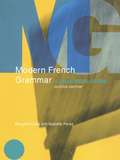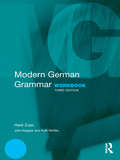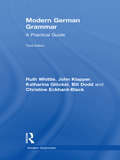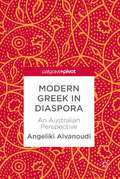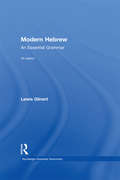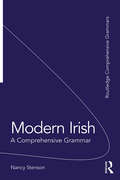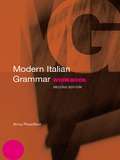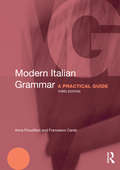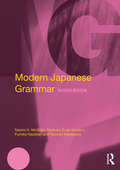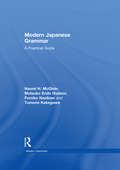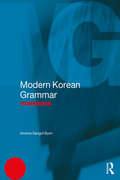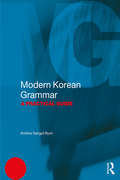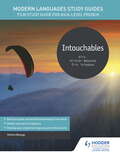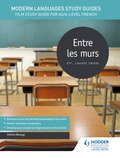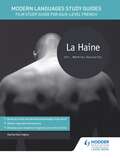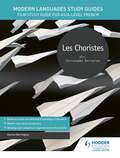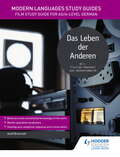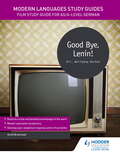- Table View
- List View
Modern French Grammar: A Practical Guide (Modern Grammars)
by Isabelle Perez Margaret LangThis new edition of the Modern French Grammar is an innovative reference guide to French, combining traditional and function-based grammar in a single volume. Divided into two parts, Part A covers traditional grammatical categories such as word order, nouns, verbs and adjectives and Part B is organized around language functions and notions such as: giving and seeking information describing processes and results expressing likes, dislikes and preferences. With a strong emphasis on contemporary usage, all grammar points and functions are richly illustrated with examples. Implementing feedback from users of the first edition of the Grammar, this second edition includes clearer explanations and greater emphasis on areas of particular difficulty for learners of French. This is the ideal reference grammar for learners of French at all levels, from beginner to advanced. No prior knowledge of grammatical terminology is assumed and a glossary of grammatical terms is provided. This Grammar is complemented by the Modern French Grammar Workbook Second Edition which features related exercises and activities.
Modern German Grammar Workbook (Modern Grammar Workbooks)
by Heidi Zojer John Klapper Ruth Whittle William J Dodd Christine Eckhard-BlackModern German Grammar Workbook, Third Edition, is an innovative book of exercises and language tasks for intermediate and advanced learners of German. The book is divided into three sections: Section 1 provides exercises based on essential grammatical structures. Section 2 practises everyday functions (e.g. making introductions, apologising, expressing needs). Section 3 contains realistic role-plays in short scenes, set in a range of different contexts. A comprehensive answer key at the back of the book enables you to check on your progress. Implementing feedback from users of the second edition, this third edition now features: even more extensive cross-referencing to the related Modern German Grammar, Third Edition spelling following the latest reform representation of the German of Switzerland and Austria. Modern German Grammar Workbook, Third Edition, is ideal for all learners who want to deepen their knowledge of German, including intermediate and advanced students at schools, in adult education and within higher education. It can be used independently or alongside Modern German Grammar, Third Edition (ISBN 978-0-415-56726-8) also published by Routledge.
Modern German Grammar: A Practical Guide (Modern Grammars)
by John Klapper Ruth Whittle Christine Eckhard-Black Katharina Glöckel Bill DoddModern German Grammar: A Practical Guide, Third Edition is an innovative reference guide to German, combining traditional and function-based grammar in a single volume. The Grammar is divided into two parts. Part A covers grammatical categories such as word order, nouns, verbs and adjectives. Part B is organised according to language functions and notions such as: making introductions asking for something to be done delivering a speech possibility satisfaction. The book addresses learners’ practical needs and presents grammar in both a traditional and a communicative setting. New to this edition, and building on feedback from the previous edition: The rules of the latest (and so far final) spelling reform have been implemented throughout. Examples of usage have been updated and consideration given to Swiss and Austrian variants. The chapter on register has been expanded and now includes youth language and frequently used Anglicisms in German. The Index now has even more key words; it has also been redesigned to differentiate between German words, grammar terms, and functions, thus making it more user-friendly. The Grammar assumes no previous grammatical training and is intended for all those who have a basic knowledge of German, from intermediate learners in schools and adult education to undergraduates taking German as a major or minor part of their studies. The Grammar is accompanied by a third edition of Modern German Grammar Workbook (ISBN 978-0-415-56725-1) which features exercises and activities directly linked to the Grammar. Ruth Whittle is Lecturer, John Klapper is Professor of Foreign Language Pedagogy, Katharina Glöckel is the Austrian Lektorin and Bill Dodd is Professor of Modern German Studies – all at the University of Birmingham. Christine Eckhard-Black is Tutor and Advisor in German at the Oxford University Language Centre.
Modern Greek in Diaspora: An Australian Perspective
by Angeliki AlvanoudiThis book presents an in-depth fieldwork-based study of the Greek language spoken by immigrants in Cairns, Far North Queensland, Australia. The study analyzes language contact-induced changes and code switching patterns, by integrating perspectives from contact linguistics and interactional approaches to language use and code switching. Lexical and pragmatic borrowing, code mixing, discourse-related and participant-related code switching, and factors promoting language maintenance are among the topics covered in the book. The study brings to light original data from a speech community that has received no attention in the literature and sheds light on the variation of Greek spoken in diaspora. It will appeal across disciplines to scholars and students in linguistics, anthropology, sociology, and migration studies.
Modern Hebrew: An Essential Grammar (Routledge Essential Grammars Ser.)
by Lewis GlinertThis fourth edition of Hebrew: An Essential Grammar includes expanded coverage of some of the key areas of Hebrew grammar including roots, adverbs and nouns. Additional examples have been added throughout to further clarify many of the grammar points with illustrations from current usage. The Grammar serves as a reference source for the learner or user of Hebrew irrespective of level, by setting out the complexities of the language in short, readable sections that are clear and free from jargon. It is ideal both for independent study and for students on taught course.
Modern Irish: A Comprehensive Grammar (Routledge Comprehensive Grammars)
by Nancy StensonModern Irish: A Comprehensive Grammar is a complete reference guide to modern Irish grammar, providing a thorough overview of the language. Key features include: highly systematic coverage of all levels of structure: sound system, word formation, sentence construction and connection of sentences authentic examples and English translations which provide an accessible insight into the mechanics of the language an extensive index, numbered sections, cross-references and summary charts which provide readers with easy access to the information. Modern Irish: A Comprehensive Grammar is an essential reference source for the learner and user of Irish. It is ideal for use in schools, colleges, universities, and adult classes of all types.
Modern Italian Grammar Workbook (Modern Grammar Workbooks)
by Anna ProudfootThis is an innovative book of exercises and language tasks for all learners of Italian, which can be used independently or alongside Modern Italian Grammar. Divided into three sections, this highly useful text includes: exercises based on essential grammatical structures everyday functions practice such as making introductions and expressing needs realistic role plays in short scenes, set in a range of different contexts. Implementing feedback from its predecessor, this updated second edition features exercises graded on a three-point scale according to their level of difficulty and cross-referencing to the Modern Italian Grammar for each. Also containing a comprehensive answer key for checking progress, this is a complete reference work suitable for both class-use and self-study.
Modern Italian Grammar: A Practical Guide (Modern Grammars)
by Anna Proudfoot Francesco CardoThis new edition of the Modern Italian Grammar is an innovative reference guide to Italian, combining traditional and function-based grammar in a single volume. With a strong emphasis on contemporary usage, all grammar points and functions are richly illustrated with examples. Implementing feedback from users of the first edition, this text includes clearer explanations, as well as a greater emphasis on areas of particular difficulty for learners of Italian. Divided into two sections, the book covers: traditional grammatical categories such as word order, nouns, verbs and adjectives language functions and notions such as giving and seeking information, describing processes and results, and expressing likes, dislikes and preferences. This is the ideal reference grammar for learners of Italian at all levels, from beginner to advanced. No prior knowledge of grammatical terminology is needed and a glossary of grammatical terms is provided. This Grammar is complemented by the Modern Italian Grammar Workbook Second Edition which features related exercises and activities.
Modern Japanese Grammar Workbook (Modern Grammar Workbooks)
by Fumiko Nazikian Naomi McGloin M. Endo Hudson Tomomi KakegawaThe Modern Japanese Grammar Workbook is an innovative book of exercises and language tasks for all learners of Japanese. The book is divided into two parts: Section A provides exercises based on essential grammatical structures Section B practises everyday functions (e.g. making introductions, apologizing, expressing needs). All sentences are written both in Romanization and in the Japanese script and a comprehensive answer key at the back enables the learner to check on their progress. Key features of the book include: Exercises graded on a 3-point scale according to their level of difficulty Cross-referencing to the related Modern Japanese Grammar Topical exercises drawn from realistic scenarios to help learners develop their vocabulary and practical communication skills Opportunities to practise both written and spoken Japanese. Modern Japanese Grammar Workbook is an ideal practice tool for learners of Japanese at all levels. No prior knowledge of grammatical terminology is assumed and it can be used both independently and alongside the Modern Japanese Grammar (ISBN 978-0-415-57201-9), which is also published by Routledge.
Modern Japanese Grammar: A Practical Guide (Modern Grammars Ser.)
by Fumiko Nazikian M. Endo HudsonFirst published in 2013. As with its series counterparts, this is an innovative reference guide to the Japanese language, combining traditional and function-based grammar in a single volume. In its two-part structure, Part A covers traditional grammatical categories, such as structural features of the language and the behaviour of parts of speech. With a strong emphasis on contemporary usage, all grammar points are richly illustrated with examples written in a combination of hiragana, katakana and kanji, alongside romanizations and sentence meanings in English.Part B is organised around language functions such as expressing likes and dislikes, giving and seeking information, making decisions and apologising. This function-based presentation is an invaluable guide to the situationally-appropriate use of Japanese for learners at all levels. The two parts of the Grammar are closely linked by extensive cross-references, providing a grammatical and a functional perspective on many patterns in the language. This is the ideal reference grammar for learners of Japanese at all levels, from novice to advanced. No prior knowledge of grammatical terminology is assumed and a glossary of grammatical terms is provided.
Modern Korean Grammar Workbook
by Andrew Sangpil ByonRoutledge’s Modern Grammar series is an innovative reference guide combining traditional and function-focused grammar in a single volume, with an accompanying workbook.The aim of the Modern Korean Grammar Workbook is to strengthen the reader’s understanding of the main volume, Modern Korean Grammar.. Designed for those who have already acquired the basics of the language, this workbook provides abundant innovative exercises for both essential grammatical features and everyday usage and functions (e.g., giving advices, greetings, requesting, etc.). The Modern Korean Grammar Workbook is an ideal practice tool for Korean-as a foreign/second (KFL) learners. No prior knowledge of grammatical terminology is assumed and it can be used both independently and alongside Modern Korean Grammar.
Modern Korean Grammar: A Practical Guide (Modern Grammars)
by Andrew Sangpil ByonRoutledge’s Modern Grammar series is an innovative reference guide combining traditional and function-focused grammar in a single volume, with an accompanying workbook. The aim of the Modern Korean Grammar is to provide an overview of the structures and functions of the Korean language. Designed for those who have already acquired the basics of the language, the book combines a comprehensive description of the grammatical structures of Korean with a functional/usage approach to the language. All target grammatical and functional points will be illustrated with examples in Hangul with English translations for better understanding. In addition, the use of linguistic terminology is limited, to facilitate quick and easy comprehension.
Modern Languages Study Guides: Film Study Guide for AS/A-level French
by Hélène BeaugyFilm analysis made easy. Build your students' confidence in their language abilities and help them develop the skills needed to critique their chosen work: putting it into context, understanding the themes and director's technique, as well as specialist terminology.Breaking down each scene, character and theme in Intouchables (Untouchables), this accessible guide will enable your students to understand the historical and social context of the film and give them the critical and language skills needed to write a successful essay.- Strengthen language skills with relevant grammar, vocab and writing exercises throughout- Aim for top marks by building a bank of textual examples and quotes to enhance exam response- Build confidence with knowledge-check questions at the end of every chapter- Revise effectively with pages of essential vocabulary and key mind maps throughout- Feel prepared for exams with advice on how to write an essay, plus sample essay questions, two levels of model answers and examiner commentary
Modern Languages Study Guides: Film Study Guide for AS/A-level French
by Hélène BeaugyFilm analysis made easy. Build your students' confidence in their language abilities and help them develop the skills needed to critique their chosen work: putting it into context, understanding the themes and director's technique, as well as specialist terminology.Breaking down each scene, character and theme in Entre les murs, this accessible guide will enable your students to understand the historical and social context of the film and give them the critical and language skills needed to write a successful essay.- Strengthen language skills with relevant grammar, vocab and writing exercises throughout- Aim for top marks by building a bank of textual examples and quotes to enhance exam response- Build confidence with knowledge-check questions at the end of every chapter- Revise effectively with pages of essential vocabulary and key mind maps throughout- Feel prepared for exams with advice on how to write an essay, plus sample essay questions, two levels of model answers and examiner commentary
Modern Languages Study Guides: Film Study Guide for AS/A-level French
by Hélène BeaugyFilm analysis made easy. Build your students' confidence in their language abilities and help them develop the skills needed to critique their chosen work: putting it into context, understanding the themes and director's technique, as well as specialist terminology.Breaking down each scene, character and theme in Intouchables (Untouchables), this accessible guide will enable your students to understand the historical and social context of the film and give them the critical and language skills needed to write a successful essay.- Strengthen language skills with relevant grammar, vocab and writing exercises throughout- Aim for top marks by building a bank of textual examples and quotes to enhance exam response- Build confidence with knowledge-check questions at the end of every chapter- Revise effectively with pages of essential vocabulary and key mind maps throughout- Feel prepared for exams with advice on how to write an essay, plus sample essay questions, two levels of model answers and examiner commentary
Modern Languages Study Guides: Film Study Guide for AS/A-level French
by Karine HarringtonFilm analysis made easy. Build your students' confidence in their language abilities and help them develop the skills needed to critique their chosen work: putting it into context, understanding the themes and director's technique, as well as specialist terminology.Breaking down each scene, character and theme in Au revoir les enfants, this accessible guide will enable your students to understand the historical and social context of the film and give them the critical and language skills needed to write a successful essay.- Strengthen language skills with relevant grammar, vocab and writing exercises throughout- Aim for top marks by building a bank of textual examples and quotes to enhance exam response- Build confidence with knowledge-check questions at the end of every chapter- Revise effectively with pages of essential vocabulary and key mind maps throughout- Feel prepared for exams with advice on how to write an essay, plus sample essay questions, two levels of model answers and examiner commentary
Modern Languages Study Guides: Film Study Guide for AS/A-level French
by Karine HarringtonFilm and Literature analysis made easy. Build your students' confidence in their language abilities and help them develop the skills needed to critique their chosen work; putting it into context, understanding the themes and director's technique, as well as specialist terminology.Breaking down each scene, character and theme in La Haine, this accessible guide will enable your students to understand the historical and social context of the film and give them the critical and language skills needed write a successful essay.- Strengthen language skills with relevant grammar, vocab and writing exercises throughout- Aim for top marks by building a bank of textual examples and quotes to enhance exam response- Build confidence with knowledge check questions at the end of every chapter- Revise effectively with pages of essential vocabulary and key mind maps throughout- Feel prepared for exams with advice on how to write an essay, plus sample essay questions, two levels of model answers and examiner commentary
Modern Languages Study Guides: Film Study Guide for AS/A-level French
by Karine HarringtonFilm analysis made easy. Build your students' confidence in their language abilities and help them develop the skills needed to critique their chosen work: putting it into context, understanding the themes and director's technique, as well as specialist terminology.Breaking down each scene, character and theme in Les Choristes (The Choir), this accessible guide will enable your students to understand the historical and social context of the film and give them the critical and language skills needed to write a successful essay.- Strengthen language skills with relevant grammar, vocab and writing exercises throughout- Aim for top marks by building a bank of textual examples and quotes to enhance exam response- Build confidence with knowledge-check questions at the end of every chapter- Revise effectively with pages of essential vocabulary and key mind maps throughout- Feel prepared for exams with advice on how to write an essay, plus sample essay questions, two levels of model answers and examiner commentary
Modern Languages Study Guides: Film Study Guide for AS/A-level French
by Karine HarringtonFilm analysis made easy. Build your students' confidence in their language abilities and help them develop the skills needed to critique their chosen work: putting it into context, understanding the themes and director's technique, as well as specialist terminology.Breaking down each scene, character and theme in Les Choristes (The Choir), this accessible guide will enable your students to understand the historical and social context of the film and give them the critical and language skills needed to write a successful essay.- Strengthen language skills with relevant grammar, vocab and writing exercises throughout- Aim for top marks by building a bank of textual examples and quotes to enhance exam response- Build confidence with knowledge-check questions at the end of every chapter- Revise effectively with pages of essential vocabulary and key mind maps throughout- Feel prepared for exams with advice on how to write an essay, plus sample essay questions, two levels of model answers and examiner commentary
Modern Languages Study Guides: Film Study Guide for AS/A-level French (Film and literature guides)
by Hélène BeaugyExam Board: AQA & EdexcelLevel: AS/A-levelSubject: Modern LanguagesFirst Teaching: September 2016First Exam: June 2017Film analysis made easy. Build your students' confidence in their language abilities and help them develop the skills needed to critique their chosen work: putting it into context, understanding the themes and director's technique, as well as specialist terminology.Breaking down each scene, character and theme in Entre les murs (The Class), this accessible guide will enable your students to understand the historical and social context of the film and give them the critical and language skills needed to write a successful essay.- Strengthen language skills with relevant grammar, vocab and writing exercises throughout- Aim for top marks by building a bank of textual examples and quotes to enhance exam response- Build confidence with knowledge-check questions at the end of every chapter- Revise effectively with pages of essential vocabulary and key mind maps throughout- Feel prepared for exams with advice on how to write an essay, plus sample essay questions, two levels of model answers and examiner commentary
Modern Languages Study Guides: Film Study Guide for AS/A-level French (Film and literature guides)
by Karine HarringtonExam Board: AQA, Edexcel & EduqasLevel: AS/A-levelSubject: Modern LanguagesFirst Teaching: September 2016First Exam: June 2017Film analysis made easy. Build your students' confidence in their language abilities and help them develop the skills needed to critique their chosen work: putting it into context, understanding the themes and director's technique, as well as specialist terminology.Breaking down each scene, character and theme in Au revoir les enfants (Goodbye, Children), this accessible guide will enable your students to understand the historical and social context of the film and give them the critical and language skills needed to write a successful essay.- Strengthen language skills with relevant grammar, vocab and writing exercises throughout- Aim for top marks by building a bank of textual examples and quotes to enhance exam response- Build confidence with knowledge-check questions at the end of every chapter- Revise effectively with pages of essential vocabulary and key mind maps throughout- Feel prepared for exams with advice on how to write an essay, plus sample essay questions, two levels of model answers and examiner commentary
Modern Languages Study Guides: Film Study Guide for AS/A-level French (Film and literature guides)
by Karine HarringtonExam Board: AQA, Edexcel & EduqasLevel: AS/A-levelSubject: Modern LanguagesFirst Teaching: September 2016First Exam: June 2017Film analysis made easy. Build your students' confidence in their language abilities and help them develop the skills needed to critique their chosen work: putting it into context, understanding the themes and director's technique, as well as specialist terminology.Breaking down each scene, character and theme in La Haine (Hate), this accessible guide will enable your students to understand the historical and social context of the film and give them the critical and language skills needed to write a successful essay.- Strengthen language skills with relevant grammar, vocab and writing exercises throughout- Aim for top marks by building a bank of textual examples and quotes to enhance exam response- Build confidence with knowledge-check questions at the end of every chapter- Revise effectively with pages of essential vocabulary and key mind maps throughout- Feel prepared for exams with advice on how to write an essay, plus sample essay questions, two levels of model answers and examiner commentary
Modern Languages Study Guides: Film Study Guide for AS/A-level German
by Geoff BrammallFilm analysis made easy. Build your students' confidence in their language abilities and help them develop the skills needed to critique their chosen work: putting it into context, understanding the themes and director's technique, as well as specialist terminology.Breaking down each scene, character and theme in Das Leben der Anderen, this accessible guide will enable your students to understand the historical and social context of the film and give them the critical and language skills needed to write a successful essay.- Strengthen language skills with relevant grammar, vocab and writing exercises throughout- Aim for top marks by building a bank of textual examples and quotes to enhance exam response- Build confidence with knowledge-check questions at the end of every chapter- Revise effectively with pages of essential vocabulary and key mind maps throughout- Feel prepared for exams with advice on how to write an essay, plus sample essay questions, two levels of model answers and examiner commentary
Modern Languages Study Guides: Film Study Guide for AS/A-level German
by Geoff BrammallFilm analysis made easy. Build your students' confidence in their language abilities and help them develop the skills needed to critique their chosen work: putting it into context, understanding the themes and director's technique, as well as specialist terminology.Breaking down each scene, character and theme in Good bye, Lenin!, this accessible guide will enable your students to understand the historical and social context of the film and give them the critical and language skills needed to write a successful essay.- Strengthen language skills with relevant grammar, vocab and writing exercises throughout- Aim for top marks by building a bank of textual examples and quotes to enhance exam response- Build confidence with knowledge-check questions at the end of every chapter- Revise effectively with pages of essential vocabulary and key mind maps throughout- Feel prepared for exams with advice on how to write an essay, plus sample essay questions, two levels of model answers and examiner commentary
Modern Languages Study Guides: Film Study Guide for AS/A-level German (Film and literature guides)
by Geoff BrammallExam Board: AQA, Edexcel, Eduqas & CCEALevel: AS/A-levelSubject: Modern LanguagesFirst Teaching: September 2016First Exam: June 2017Film analysis made easy. Build your students' confidence in their language abilities and help them develop the skills needed to critique their chosen work: putting it into context, understanding the themes and director's technique, as well as specialist terminology.Breaking down each scene, character and theme in Good bye, Lenin!, this accessible guide will enable your students to understand the historical and social context of the film and give them the critical and language skills needed to write a successful essay.- Strengthen language skills with relevant grammar, vocab and writing exercises throughout- Aim for top marks by building a bank of textual examples and quotes to enhance exam response- Build confidence with knowledge-check questions at the end of every chapter- Revise effectively with pages of essential vocabulary and key mind maps throughout- Feel prepared for exams with advice on how to write an essay, plus sample essay questions, two levels of model answers and examiner commentary
